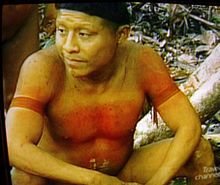- Korubo
-
Korubo or Korubu is the name given to a tribe of indigenous people living in the Javari Valley, in the Western Amazon Basin. The group calls themselves 'Dslala', and in Portuguese they are referred to as caceteiros (clubbers). Much of what the outside world knows of this group is based on the research of Brazilian explorer Sydney Possuelo who first contacted the tribe in October 1996 and journalist Paul Raffaele.
The Korubo are some of the last people on Earth to live in near isolation from modern society although they have on numerous occasions had violent contact with the surrounding communities.
An offshoot of the group is led by a woman named Maya. This splinter group has around 23 members and the larger group is estimated to have 150 members.
Contents
Culture
Their hunting and war weapon of choice is the club, and aside from poison darts they use no other ranged weapons. Their workday is about 4-5 hours long. They often live inside large, communal huts called malocas.
They have no known spiritual or religious practices. They occasionally practice infanticide for unknown reasons.[citation needed] Both men and women paint themselves with a red dye from the roucou plant.
Their diet includes fish, spider monkeys, peccary, birds, wild pig, fruit, manioc and corn. A leading cause of illness and death within the tribe is by malaria, which is brought by outsiders.[citation needed] They have some knowledge of agriculture, making clearings for harvests of crops.
A dispute between about 20 members and the main tribe caused the two bands to separate. The main tribe is for the time being in complete isolation whereas the smaller band of Korubo have frequent interaction with neighbouring settlements and FUNAI employees. Population figures of the main tribe are unknown but estimated from aerial reconnaissance of houses to be a few hundred individuals.
National Geographic Magazine wrote an article about them in its August 2003 edition called After First Contact. More recently, The Smithsonian wrote an article about the same tribe called Out of Time in its April 2005 edition.[1]
According to Ethnologue, the Korubo language may belong to the Panoan languages and may be the same as the Marúbo language.
Involvement with FUNAI
A first peaceful contact in 1972 ended tragically and over the following decades Brazil's FUNAI agency lost seven civil servants in attempts to establish a peaceful relation with them. This finally occurred in 1996.
Little is known about these people, because of FUNAI's refusal to let anthropologists study the group. After a long history from the 1950s of massacres of this indigenous people a special department of FUNAI organized an expedition in 1996 to establish a first peaceful contact with them. The Korubo in the past have killed trespassers on their land and the latest incident occurred year 2000, when Korubo warriors killed three lumbermen near the Indian Reservation. FUNAI helps the Korubo by giving them modern immunization shots and checking up on them often. FUNAI also established a national park that encompasses the Korubo's land in order to stop logging in the area. Their goal is to prevent further contact with the tribe by modern society in order to preserve their way of life for several more years.
Skirmishes with western world
- Soon after it broke away from the larger Korubo, the splinter group was chased away by the settlers of Lodario, killing two members.
- Led by their warrior Ta'van, the Korubo killed three loggers.
- Ta'van also killed close friend to Possuelo and FUNAI member, Raimundo (Sobral) Batista Magalhaes, on August 22, 1997. Sobral was attempting to take back a tarpaulin from the group.
Miscellanea
- They are commonly referred to as "Korubo" although this is not the name they have given themselves. In fact "Korubo" is a degrading, negative label given by a former enemy tribe and later adopted as a tribal designation by the outside world.[citation needed]
- Among local people they are often referred to as "caceteiros" which was wrongly translated by a French journalist as "headsmashers" because of the similarity to the French word "casse-tête". "Caceteiro", however, actually means "clubber" or "man with a club", referring simply to their weapons, just as the neighbouring isolated people called "Flecheiros" are simply "archers", also referring to the weapons they use.[citation needed]
See also
- Sydney Possuelo - The protector of Uncontacted Indians
- Other Uncontacted Groups of Brazil
Notes
External links
- Out Of Time by Paul Raffaele, Smithsonian April 2005
- The Last Tribal Battle by Diana Schemo New York Times October 1999
- Death of Expert in Indigenous Issues Could Have Been Avoided Indianist Missionary Council Newsletter n. 275
- Ethnologue Report for Korubo
Categories:- Indigenous peoples of the Amazon
- Indigenous peoples in Brazil
Wikimedia Foundation. 2010.

